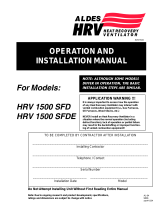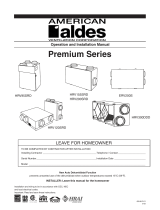Page is loading ...

Series 160S “S” Type Pitot Tubes
Operating Instructions
Bulletin H-12
TAKING AIR VELOCITY READINGS
To measure air velocity with a Series 160S Pitot Tube, make a 13/16˝ (20 mm) opening
in side of duct. Permanent-mount models require a 1˝ female NPT opening. Note:
permanent mounting is not recommended with insertion lengths over 24˝ (61 cm)
due to risk of excessive deection. Connect tubing from total pressure port to high
pressure side of manometer and from static pressure port to the low pressure side. If
reading is negative, reverse connections.
Make a series of readings traversing the duct in horizontal and vertical planes. Using
velocity pressures recorded at each location, calculate velocities and average them for
nal velocity value. If circumstances do not permit or require an accurate traverse,
center the pitot tube in the duct, determine the pressure differential (velocity pressure),
calculate actual center velocity, and multiply this value by 0.9. Tests run in this manner
should be accurate within ±5%.
CALCULATING VELOCITY
Air Velocity = 1096.2 (Cp)
where:
P
v = Sensed pressure difference (velocity pressure) in inches of water column
D = Air density in lbs./ft.
3
(dry air = 0.075)
C
p = Pitot tube coefcient: 0.84
Air Density = 1.325 X
P
B = Barometric pressure in inches of mercury
T = Absolute Temperature (Indicated Temperature in °F plus 460)
Flow in cubic feet per minute equals duct cross sectional area in square feet x air
velocity in feet per minute.
With dry air at 29.9 inches of mercury, air velocity can be read directly from temperature
correction charts on reverse.
Round Duct
Traverse on Round and Square Duct Areas
SERIES 160S PITOT TUBES are designed to meet the need of the environmental
testing eld for an inexpensive, yet accurate and reliable way to measure the ow
of particulate-laden air or gas streams. These pitot tubes use large 5/16˝ diameter
stainless steel tubing for both total and static pressures to avoid plugging. Versatile
1/8˝ female NPT connections enable use with any type of piping or tubing. Two
barbed tubing adapters are included for use with 3/16˝ I.D. rubber or vinyl tubing.
INTRODUCTION
The total pressure of a owing air stream in a duct or pipe is the sum of the static
or bursting pressure exerted on the sidewalls and the velocity or impact pressure of
the moving air. The difference between total and static pressure is called velocity
pressure, which can be used to determine the linear rate of air movement expressed
in FPM (feet per minute). A pitot tube has two tubes arranged to sense both pressures
simultaneously. By connecting these two tubes differentially to a manometer, velocity
pressure is indicated directly and the corresponding air velocity can be calculated after
applying the appropriate correction factor.
For maximum accuracy of ±2%, as in laboratory applications, care is required and the
following recommendations
should be followed.
1. Duct diameter should be 4˝ or larger.
2. Point total pressure opening upstream facing ow
and static pressure opening downstream pointing in
the direction of the ow. The faces of both openings
must be perpendicular to the airow.
3. Make an accurate traverse per drawings; calculate the
the velocities at each point and average them.
4. Take readings in a smooth, straight duct section a
minimum of 82 duct diameters in length upstream
and 12 diameters downstream from the pitot tube.
5. Provide an egg-crate type straightener upstream from
the pitot tube.
EQUAL CONCENTRIC
AREAS
R
D
CENTERS OF
A
REA OF THE
EQUAL
CONCENTRIC
A
REAS
.316
R.
.548 R.
.707 R.
.837 R.
.949 R.
A
B
16.64 EQUAL
RECTANGULAR
AREAS
CENTERS
OF AREAS
PITOT TUBE STATION INDICATED BY
P
B
T
Pv
D
Rectangular Duct
®
DWYER INSTRUMENTS, INC.
P.O. BOX 373 • MICHIGAN CITY, INDIANA 46360, U.S.A.
Phone: 219/879-8000
Fax: 219/872-9057
www.dwyer-inst.com
e-mail: [email protected]

©Copyright 2017 Dwyer Instruments, Inc. Printed in U.S.A. 2/17 FR# 440778-00 Rev. 6
70ºF
40ºF
100ºF
200ºF
300ºF
400ºF
600ºF
800ºF
1000ºF
1200ºF
1400ºF
0
200
400
600
800
1,000
1,200
1,400
1,600
1,800
2,000
2,200
2,400
2,600
2,800
3,000
3,200
0.00 0.01 0.02 0.03 0.04 0.05 0.06 0.07 0.08 0.09 0.10 0.11 0.12 0.13 0.14 0.15 0.16 0.17 0.18 0.19 0.20
AIR VELOCITY IN FEET PER MINUTE
GAGE READING WITH 160S PITOT TUBE (VELOCITY PRESSURE) IN INCHES OF WATER
70º
F
40º
F
100º
F
200º
F
300º
F
400º
F
600ºF
800ºF
1000º
F
1200º
F
1400º
F
0
1,000
2,000
3,000
4,000
5,000
6,000
7,000
8,000
9,000
10,000
11,000
12,000
13,000
14,000
0.00.2 0.40.6 0.81.0 1.21.4 1.61.8 2.02.2 2.42.6 2.83.0 3.23.4 3.63.8 4.0
AIR VELOCITY IN FEET PER MINUTE
GAGE READING WITH 160S PITOT TUBE (VELOCITY PRESSURE) IN INCHES OF WATER
DWYER INSTRUMENTS, INC.
P.O. BOX 373 • MICHIGAN CITY, INDIANA 46360, U.S.A.
Phone: 219/879-8000
Fax: 219/872-9057
www.dwyer-inst.com
e-mail: [email protected]
/

